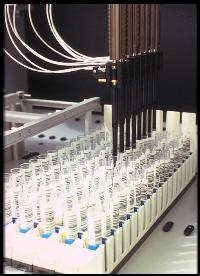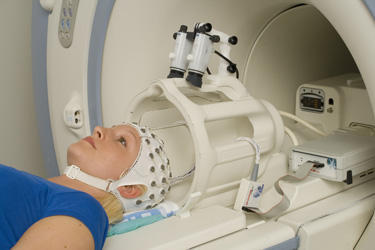Main content
Current research projects:
1) Effects of epilepsy on pregnancy, delivery and outcome for the child
Epilepsy is the most common neurological disorder in mothers. Epilepsy has great influence on quality of life and is associated with cognitive difficulties, low socioeconomic status, depression and anxiety. There is also a suspicion of increased rate of eating disorders and obesity among women with epilepsy. In addition pregnancy can have a negative effect on psychiatric disease and vice versa. This has not yet been fully investigated in women with epilepsy and need further studying.
Women with epilepsy are especially vulnerable during pregnancies and several obstetrical complications such as preeclampsia, gestational hypertension, caesarian delivery, congenital malformations and low birth weight occur more frequently than in women without epilepsy. Adverse cognitive outcome and delayed verbal, motor and social development has been suspected in children exposed to antiepileptic drugs.
Our studies are based on The Norwegian Mother and Child cohort study (MoBa) linked to the Medical Birth Registry of Norway, which includes more than 100.000 pregnant women and their partners included in the study during gestational week 16-18 and followed until the child is 8 years old. Almost 700 of these women and 600 men were diagnosed with epilepsy. This group is being compared to a reference group without epilepsy as well as to mothers with other chronic diseases. This presents us with a unique opportunity to examine adverse effects and risk factors concerning parental psychiatric disease, socioeconomic factors and physical health in parents with epilepsy. In addition we examine the effect parental epilepsy has on offspring outcome. This will enable us to suggest improvements in guidelines in epilepsy treatment in relation to family life.
Project manager: Marte Helene Bjørk
2) Status epilepticus
This project analyzes the outcome after enduring epileptic seizures (status epilepticus).
Status epilepticus (SE) can occur in patients with known epilepsy, but equally frequent as a first time seizure. There are as many forms of SE as there are seizure types, but the most feared form of SE is the generalized tonic clonic form. There are many case reports and case series describing poor outcome, but few are systematic, and it is difficult to separate the outcome after SE from consequences of the underlying causes of the condition. This is in particular true for cognitive outcome.
We study outcome after SE in general, and specifically we measure cognitive functioning after the event with a computerized cognitive test battery. The tests are repeated after one year together with traditional neuropsychological tests. Results from patients with SE are compared to controls and to patients with more than 10 generalized tonic clonic seizures, but without SE. We collect material for biomarkers in the blood indicative of neuronal damage for further analyses, and we have obtained MRI of a number of the included patients.
Our group also investigate the treatment of established SE. Fosphenytoin is the most commonly used agent in Norway. We are measuring serum levels of this agent during the first hour after it is administrated. The aim is to outline a how the concentration varies in the blood depending on several clinica, biochemical and genetical variables. Our goal is to learn how this can affect treatment success in different people. Potentially this can lead to more tailored treatment for future patients.
3) Quantitative correlations of visual EEG analysis in patients with epilepsy based on the SCORE-Standard
Visual EEG interpretation is the current gold standard in EEG diagnostics. However, the diagnostic accuracy is not satisfactory. EEG nomenclature includes qualitative definitions, leaving room for subjective interpretation which contributes to low interrater agreement, not least for interictal epileptiform activity, the most relevant biomarker for epilepsy.
The purpose of this project is to increase the precision of visual EEG analysis, especially regarding epilepsy diagnostics, by providing semi-quantitative measures. Our structured and unique EEG report database contains EEG reports on 10 547 patients during the period 2013-2017, out of which 1 309 patients have epilepsy. The EEG reports contain all clinically relevant data as well as the raw EEG signals, making it possible to quantify specific findings. We will put an emphasis on exploring measures that distinguish epileptic activity from normal activity. Similarly, we will quantify EEG background activity to find measures that distinguish encephalopathic from normal background activity. Methods, algorithms and results will all be made publicly available. Our scientific work will improve objectiveness and interrater reliability in EEG diagnostics.
Project manager: Eivind Aanestad
4) Epilepsy and Cancer
The purpose of this project is to analyze the clinical and para- clinical aspects of symptomatic epilepsy in adult patients with glioma grade II - IV. Up to 85% of patients with low grade glioma and up to 50% of patients with high grade glioma develop epilepsy. Antiepileptic drugs can interact with oncological treatment and often have side-effects. The project is divided into three parts. The first part is a registry coupling analysis of data from Cancer Registry of Norway, the Norwegian Prescription Database and the Cause of Death Registry of Norway. These national registers allow mapping of epidemiological and therapeutic changes over time in the treatment of Norwegian glioma patients with epilepsy. The second part is to characterize the course of status epilepticus in glioma through a prospective observational study of glioma patients with epilepsy. Since 2009 we have included patients with glioma grade II-IV and epilepsy in a prospective study. Information on relation to cancer disease, semiology, treatment response and recurrence is registered. In the third part of the project, we will examine EEG combined with MRI as a measure of epileptic activity in patients with glioma, recruited from the prospective database. Epilepsy is a network disturbance and EEG compared with MRI will better be able to map epileptic activity and provide additional information about the impact of glioma in cortical networks.
5) Effect of maternal folic acid supplement use, maternal plasma folate, and AED concentrations during pregnancy on language development in children of mothers with epilepsy aged 18 months-8 years
Most pregnant women with epilepsy are dependent on antiepileptic drug use (AED) throughout the pregnancy in order to prevent epileptic seizures. In utero exposure to AEDs is associated with an increased risk of congenital malformations, impaired neurodevelopment and an increased risk of behavioral disorders in the offspring.
Folic acid is a B vitamin important for normal brain development in utero. Many AEDs interact with folate metabolism, causing reduced plasma folate. There is growing evidence of a positive association between maternal folate status during pregnancy and neurodevelopmental outcome in the offspring. Few studies have examined whether folic acid supplementation protects against impaired neurodevelopment after AED exposure in utero.
The aim of my project is to investigate the effect of maternal folic acid supplement use, maternal plasma folate, and AED concentrations during pregnancy on language development in children of mothers with epilepsy aged 18 months-8 years. The project also aim to examine the relationship between different common maternal genetic polymorphisms involved in folate metabolism, AED concentrations and language development in children of mothers with epilepsy. The overall aim with the project is to identify factors that reduce the risk of AED-related fetal harm.
The study population are women and children included in the Norwegian Mother and Child Cohort Study. This is a prospective, ongoing population-based pregnancy cohort study conducted by the Norwegian Institute of Public Health and linked to the compulsory Medical Birth Registry of Norway.
Project manager: Elisabeth Synnøve Nilsen Husebye
6) Epilepsy and epilepsy treatment in patients with glioma
In 2017, there were 452 newly diagnosed malignant CNS tumors¹. Of all new brain tumors, about 40% are gliomas. The World Health Organization grades gliomas after increasingly biological aggressiveness. Up to 90% of patients with a low grade glioma (WHO grade II) and up to 60% of patients with a high grade glioma (WHO grade III-IV), experience epileptic seizures.
https://sb.kreftregisteret.no/insidens
Complicating factors of the epilepsy treatment are drug interactions with chemotherapy and adverse drug effects from the anti-epileptic drugs (AEDs). Optimal choice of AED is thus also important to preserve the patients’ quality of life. This project aims to identify the AED with best possible treatment efficacy while preserving the patients` quality of life is.
Included in the project is a linkage of data from three national health registries; The Cancer Registry of Norway, the Norwegian Prescription Database and the Cause of Death Registry in Norway. In the first part of this project, we analysed the overall survival of patients with glioma grade IV in relation to the treatment with different AEDs:
http://www.ncbi.nlm.nih.gov/pubmed/27377653
The most recent study based on the data from the national health registries investigated the use of different AEDs as risk factor for the need of psychiatric co-medication in patients with glioma grade II-III or grade IV:
https://www.ncbi.nlm.nih.gov/pubmed/30471051
We have an ongoing prospective observational study in two Western Norwegian counties; Hordaland and Sogn og Fjordane for all adults diagnosed with glioma grade II-IV and at least one epileptic seizure related to the glioma. The first paper published from this study was about status epilepticus, which are long-duration epileptic seizures:
http://www.ncbi.nlm.nih.gov/pubmed/27367838
Currently, we are working on a collaborative study together with Centre for tumor-related epilepsy at the Regina Elena National Cancer Institute in Italy.
7) SCAN-AED: Nordic register-based study of antiepileptic drugs in pregnancy
SCAN-AED is a Nordic multi-registry study aiming to find the optimal choice of antiepileptic drugs (AEDs) and folic acid treatment during pregnancy. We will examine the risk of physical and neuropsychiatric disease in the child after exposure to different antiepileptic drugs taken alone or in combination during pregnancy. We will also investigate how high dose folic acid modifies this risk. Maternal health during and after pregnancy will also be studied.
8) EpiReg – a research and quality registry for epilepsy at Haukeland University Hospital, Bergen
EpiReg is a research- and quality registry and biobank for patients treated at Department of Neurology, Haukeland University Hospital. The aim of EpiReg is to use the collected information to increase quality and excellence in epilepsy treatment. We also use the information for research EpiReg is initated and maintained by Bergen Epilepsy Research Group (BERG).
EpiReg was established in 2019 with funding from Helse Vest, later also from Helse Bergen. The regional ethical committee has approved it (REK 2018/586). The database is integrated with the hospital record system of the hospital so that all registered information is also visible in the patient’s individual hospital record. EpiReg was established in cooperation with Norsk Epilepsiforbund, the national patient organization, and it has continuous user support. EpiReg interacts with the national EpilepsiNett project supported by the Research Council of Norway.
EpiReg collects both patient-reported data and medical information. The aim is to include both initial patient information and regular follow-up data. The registry has a particular focus on pregnant women with epilepsy and on women of childbearing-age. Our future aim is to expand the registry to include all patients with epilepsy. Clinical information will be combined with biomarker studies. BERG has ongoing EEG research projects, and these projects also plan to use EpiReg-data. The recent EpiNy-project will combine biomarker and clinical data in first-seizure patients and at epilepsy debut. Inclusion in EpiReg is ongoing. Participants give their informed consent before inclusion and can withdraw from the study at any time. They can also demand that all previous data collected about them are deleted.
Contact information:
Katrin Begall katrin.begall@helse-bergen.no
Marte H. Bjørk marte.helene.bjork@helse-bergen.no
Tel: +47 55 97 5045
Nevropoliklinikk 5597 5121
Måndag – fredag 08:00 – 15:30
Gamle Hovedbygg, 2 etasje
Jonas Lies vei 71
5053 Bergen


